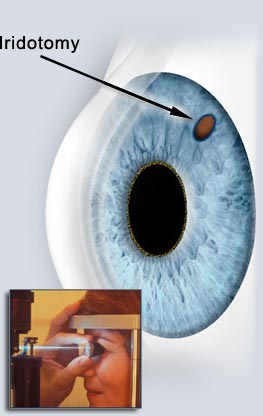Laser iridotomy is a treatment for narrow-angle glaucoma. In laser iridotomy, a small hole is placed in the iris to create a hole for fluid to drain from the back of the eye to the front of the eye. Without this new channel through the iris, intra-ocular pressure can increase rapidly in patients with narrow-angles. This can result in damage to the delicate optic nerve, and permanent loss of vision. The opening created in the iris by the laser is microscopic and only seen with microscopic evaluation of the eye.
A small hole is created in the iris by the laser so that fluid can drain from the back to the front of the eye.
The purpose of an iridotomy is to lower pressure and preserve vision.
Laser iridotomy is indicated for patients:
- diagnosed with closed-angle glaucoma.
- with narrow-angles which are at risk for angle closure.
What to expect on procedure day:
Your treatment will be performed in a standard exam room at the office of Karlik Ophthalmology. It does not require a surgery center. Drops will be used to numb your eye; no injections or needles are used.
Your doctor will place a special contact lens on your eye to focus the laser light upon the iris. This lens keeps your eyelids separated so you will not blink during treatment. It also reduces small eye movements so that you do not have to worry about your eye moving during the treatment. To ensure that the contact lens does not scratch your eye, a special jelly will be placed on the surface of your eye. This jelly may remain on your eye for about thirty minutes, leading to blurred vision or a feeling of heaviness.
During the laser treatment, you may see a bright light, like a photographer's flash from a close distance. Also, you may feel a pinch-like sensation. The treatment lasts a very short time.
Drops may be prescribed to alleviate any soreness or swelling inside your eye. Follow-up visits are necessary to monitor your eye pressure.
Everyone heals differently, but most people resume normal activities immediately following treatment. Most patients are able to drive home following the procedure. For the next few days your eyes may be red, a little scratchy and sensitive to light.
Realistic expectations:
Serious complications with laser iridotomy are extremely rare, but like any medical procedure, it does have some risks. The chance of losing vision following a laser procedure is extremely small. The main risks of a laser iridotomy are that your iris might be difficult to penetrate, requiring more than one treatment session. Another risk is that the hole in your iris will close.
Following your procedure, you may still require medications or other treatments to keep your eye pressure sufficiently low. This additional treatment will be necessary if there was damage to the trabecular meshwork prior to the iridotomy or if you also have another type of glaucoma in addition to the narrow-angle type.